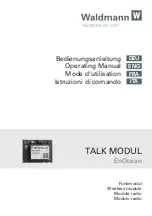
5G OUTDOOR CPE FW2010 USER GUIDE
55
•
TTY
— Text Telephones (TTY), also known as Telecommunications Device for the Deaf (TDD), are
used by the deaf, hard–of–hearing, and individuals with speech impairments to communicate.
•
UDP
— User Datagram Protocol (UDP) is a communications protocol that offers a limited
amount of service when messages are exchanged between computers in a network that uses
the Internet Protocol (IP). UDP is an alternative to the Transmission Control Protocol (TCP) and,
together with IP, is sometimes referred to as UDP/IP.
•
USB
— Universal Serial Bus. A connection type for computing device peripherals such as a
printer, mobile modem, etc.
•
USB Port Types
—USB ports on computers and hubs have a rectangular Type A port, and
peripheral devices have a cable with a Type A connector. Peripheral devices that do not have an
attached cable typically have a Type C port on the device and a separate Type A to C cable. Type
B connectors have been replaced by Type C. Mini-USB connectors have largely been superseded
by Micro-USB, but are still used with some cameras, music players, etc. Micro-USB connectors
are used with portable devices, such as phones and battery packs, although USB-C is being
adopted by most manufacturers.
•
USSD
—
Unstructured Supplementary Service Data (USSD), also known as “Quick code” or
“Feature code”, is a communications protocol used to send data between a mobile device and
network service provider.
•
VPN
— Virtual Private Network. A secure private network that runs over the public Internet.
Commonly used to connect to an office network from elsewhere.
•
Wi-Fi
— Any system that uses the 802.11 standard developed and released in 1997 by the IEEE.
•
Wi-Fi 5
—The fifth generation of Wireless Fidelity, using 802.11ac on 5 GHz. This standard was
developed and released in 2013.
•
Wi-Fi 6
—The sixth generation of Wireless Fidelity, using 802.11ax on licensed exempt bands
between 1 and 6 GHz. This standard was developed in 2020.
•
Wi-Fi Client
— A wireless device that connects to the Internet via Wi-Fi
•
WPA/WPA2
— Wi-Fi Protected Access. A security protocol for wireless 802.11 networks from
the Wi-Fi Alliance.
•
WPA3
—The next generation of Wi-Fi Protected Access. WPA3 simplifies security, provides
more robust authentication, increased cryptographic strength, and offers additional capabilities
for personal and enterprise networks. WPA3 retains interoperability with WPA2 devices.

































